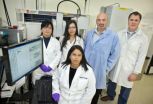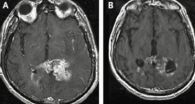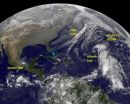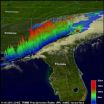(Press-News.org) Since the 1970s, U.S. mortality rates due to colorectal cancer have declined overall, yet among blacks and Hispanics, the death rates rose. Evidence suggests that underuse of colonoscopy screening among these groups is one reason for the large disparities. In 2003, New York City launched a multifaceted campaign to improve colonoscopy rates among racial and ethnic minorities and women. A new study conducted by researchers at Columbia University's Mailman School of Public Health and the NYC Department of Health and Mental Hygiene demonstrates the notable success of the campaign. Results show a 20-percentage point jump in colonoscopy screenings among all New Yorkers ages 50 and older and the elimination of disparities across several demographic populations.
Full study findings are published online in the American Journal of Gastroenterology and featured in their highlights of important findings called the Red Section.
Results from the study show that the number of New Yorkers aged 50 years and older who reported at least one colonoscopy screening within the past 10 years increased from 41.7% in 2003 to 61.7% in 2007. Timely colonoscopy screenings for six categories of New Yorkers – race/ethnicity, sex, insurance status, poverty level, education and age -- show disparities eliminated over the five-year study span among non-Hispanic whites, non-Hispanic blacks and Hispanics as well as a 29-percentage point increase over time for screening among Asians.
While men had a higher rate of colonoscopies when the campaign was introduced in 2003, women closed the gap: their screening rate rose 22.3%, as opposed to a 16.7% increase among men.
The campaign to improve colonoscopy rates in NYC was developed by Department of Health and Mental Hygiene (NYCDOH) in collaboration with the Citywide Colon Cancer Control Coalition. It included media campaigns on subways, ethnic radio stations and at check cashing sites, plus an outreach through the medical community. Health Department epidemiologists, evaluated the effectiveness of the Coalition's campaign to increase screening and were also co-authors of the paper.
Other components included an expanded capacity for colonoscopy at the public hospital system and streamlined colonoscopy referral system.
Data were analyzed from the Community Health Survey (CHS), a population-based, random telephone survey of New Yorkers that has been administered annually since 2002 by the NYC DOHMH.
The study also shows that the affluent and the well-educated continue to have the highest and fastest-growing rates of colonoscopies. Between 2003 and 2007, the greatest increase was among New Yorkers who are U.S.-born, college-educated, 65 years and older, and living at 200% of the federal poverty level or. In 2007, New Yorkers with household incomes below $25,000 had a colonoscopy screening rate of 34%, vs. 59% among those with household incomes above $75,000. Adults with high household incomes—600% of the federal poverty level or more—continued to have a much higher prevalence of timely colonoscopy screening than all other income groups (73.3%).
Over time, disparities for adults with private or government-provided insurance also disappeared. However, those without insurance continued to lag -- 43.3% reported a colonoscopy screening compared to 66.8% of the privately insured, although colonoscopy screening rates among the uninsured were a mere 15% in 2003.
"These analyses show how successful the Health Department and its partners have been in closing the cancer screening gap among racial and ethnic groups across New York City, although the screening rate in the Asian population remained low," said Dr. Bonnie Kerker, senior epidemiology and policy advisor at the Department of Health. "Since this analysis was done, however, the screening rate among Asians has increased from 53.6% percent in 2007 to 66.7 percent in 2010, a rate comparable to that among whites (68.5 percent)."
"Though there are still challenges for the uninsured, we were pleased to see that the New York City's campaign paid off, eliminating racial, ethnic and sex disparities in the use of colonoscopies. " noted Catherine Richards of the Mailman School of Public Health's Department of Epidemiology and lead author of the study. "Still, this improvement will become meaningful only if we see a corresponding reduction in deaths from colon cancer. This will need to be assessed in future studies."
###
About Columbia University's Mailman School of Public Health
Founded in 1922 as one of the first three public health academies in the nation, Columbia University's Mailman School of Public Health pursues an agenda of research, education, and service to address the critical and complex public health issues affecting New Yorkers, the nation and the world. The Mailman School is the third largest recipient of NIH grants among schools of public health. Its over 300 multi-disciplinary faculty members work in more than 100 countries around the world, addressing such issues as preventing infectious and chronic diseases, environmental health, maternal and child health, health policy, climate change & health, and public health preparedness. It is a leader in public health education with over 1,000 graduate students from more than 40 nations pursuing a variety of master's and doctoral degree programs. The Mailman School is also home to numerous world-renowned research centers including the International Center for AIDS Care and Treatment Programs (ICAP), the National Center for Disaster Preparedness, and the Center for Infection and Immunity. For more information, please visit http://www.mailman.columbia.edu
Colon cancer screening campaign erases racial, gender gaps in use of colonoscopy
Model NYC program aims to address growing disparities in colon cancer mortality rates
2011-11-21
ELSE PRESS RELEASES FROM THIS DATE:
A corny turn for biofuels from switchgrass
2011-11-21
Many experts believe that advanced biofuels made from cellulosic biomass are the most promising alternative to petroleum-based liquid fuels for a renewable, clean, green, domestic source of transportation energy. Nature, however, does not make it easy. Unlike the starch sugars in grains, the complex polysaccharides in the cellulose of plant cell walls are locked within a tough woody material called lignin. For advanced biofuels to be economically competitive, scientists must find inexpensive ways to release these polysaccharides from their bindings and reduce them to fermentable ...
Great Plains river basins threatened by pumping of aquifers
2011-11-21
CORVALLIS, Ore. – Suitable habitat for native fishes in many Great Plains streams has been significantly reduced by the pumping of groundwater from the High Plains aquifer – and scientists analyzing the water loss say ecological futures for these fishes are "bleak."
Results of their study have been published in the journal Ecohydrology.
Unlike alluvial aquifers, which can be replenished seasonally with rain and snow, these regional aquifers were filled by melting glaciers during the last Ice Age, the researchers say. When that water is gone, it won't come back – at ...
Old drugs find new target for treating brain tumor
2011-11-21
Scientists at the University of California, San Diego School of Medicine and UC San Diego Moores Cancer Center, in collaboration with colleagues in Boston and South Korea, say they have identified a novel gene mutation that causes at least one form of glioblastoma (GBM), the most common type of malignant brain tumor.
The findings are reported in the online edition of the journal Cancer Research.
Perhaps more importantly, the researchers found that two drugs already being used to treat other forms of cancer effectively prolonged the survival of mice modeling this particular ...
GOES satellite eyeing late season lows for tropical development
2011-11-21
Its late in the Atlantic and eastern Pacific hurricane seasons, but the calendar isn't stopping the tropics. The GOES-13 satellite is keeping forecasters informed about developing lows like System 90E in the eastern Pacific and another low pressure area in the Atlantic.
System 90E and the Atlantic low pressure area were both captured in one image from the NOAA's GOES-13 satellite today, November 18, 2011 at 1145 UTC (7:45 a.m. EST). The image was created by the NASA GOES Project (in partnership with NOAA) at NASA's Goddard Space Flight Center in Greenbelt, Maryland.
The ...
New NASA missions to investigate how Mars turned hostile
2011-11-21
Maybe because it appears as a speck of blood in the sky, the planet Mars was named after the Roman god of war. From the point of view of life as we know it, that's appropriate. The Martian surface is incredibly hostile for life. The Red Planet's thin atmosphere does little to shield the ground against radiation from the Sun and space. Harsh chemicals, like hydrogen peroxide, permeate the soil. Liquid water, a necessity for life, can't exist for very long here --any that does not quickly evaporate in the diffuse air will soon freeze out in subzero temperatures common over ...
Walking through doorways causes forgetting, new research shows
2011-11-21
We've all experienced it: The frustration of entering a room and forgetting what we were going to do. Or get. Or find.
New research from University of Notre Dame Psychology Professor Gabriel Radvansky suggests that passing through doorways is the cause of these memory lapses.
"Entering or exiting through a doorway serves as an 'event boundary' in the mind, which separates episodes of activity and files them away," Radvansky explains.
"Recalling the decision or activity that was made in a different room is difficult because it has been compartmentalized."
The study ...
NASA's TRMM satellite sees deadly tornadic thunderstorms in Southeastern US
2011-11-21
Tornadoes are expected to accompany severe storms in the springtime in the U.S., but this time of year they also usually happen. When a line of severe thunderstorms associated with a cold front swept through the U.S. southeast on Nov. 16, TRMM collected rainfall data on the dangerous storms from space.
NASA's Tropical Rainfall Measuring Mission (TRMM) satellite flew over the southeastern United States on November 16, 2011 at 2310 UTC (6:10 p.m. EST) when tornadoes were occurring with a line of thunderstorms that stretched from western Florida north through North Carolina. ...
A failing sense of smell can be reversed
2011-11-21
NEW YORK, November 20, 2011 – In a new study scientists at NYU Langone Medical Center have shown that the sense of smell can be improved. The new findings, published online November 20, 2011, in Nature Neuroscience, suggest possible ways to reverse the loss of smell due to aging or disease.
Smell is unique among our senses, explains Donald A. Wilson, PhD, professor of child and adolescent psychiatry at NYU Langone Medical Center and senior research scientist at the Emotional Brain Institute at Nathan S. Kline Institute for Psychiatric Research, who led the study. The ...
U-M researchers find genetic rearrangements driving 5 to 7 percent of breast cancers
2011-11-21
ANN ARBOR, Mich. — Researchers at the University of Michigan Comprehensive Cancer Center have discovered two cancer-spurring gene rearrangements that may trigger 5 to 7 percent of all breast cancers.
These types of genetic recombinations have previously been linked to blood cancers and rare soft-tissue tumors, but are beginning to be discovered in common solid tumors, including a large subset of prostate cancers and some lung cancers.
Looking at the genetic sequencing of 89 breast cancer cell lines and tumors, researchers found two distinct types of genetic rearrangements ...
Style-Passport Launches New "Winter Sun" Collection for Year-Round Jetsetters
2011-11-21
Winter is great; who doesn't love wrapping up warm, sipping hot cocoa, making snowmen and - of course - Christmas? However, for those heading abroad and swapping frosty paths for sun-kissed beaches, buying your holiday clothes at this time of year can be more daunting than Christmas dinner with the in-laws! Help is at hand, as online fashion retailer Style-Passport have launched their winter sun collection.
Boasting beautiful bikinis, stunning sarongs and contemporary kaftans (amongst other things), Style-Passport's winter sun range is perfect for picking up the beach ...
LAST 30 PRESS RELEASES:
Germline pathogenic variants among women without a history of breast cancer
Tanning beds triple melanoma risk, potentially causing broad DNA damage
Unique bond identified as key to viral infection speed
Indoor tanning makes youthful skin much older on a genetic level
Mouse model sheds new light on the causes and potential solutions to human GI problems linked to muscular dystrophy
The Journal of Nuclear Medicine ahead-of-print tip sheet: December 12, 2025
Smarter tools for peering into the microscopic world
Applications open for funding to conduct research in the Kinsey Institute archives
Global measure underestimates the severity of food insecurity
Child survivors of critical illness are missing out on timely follow up care
Risk-based vs annual breast cancer screening / the WISDOM randomized clinical trial
University of Toronto launches Electric Vehicle Innovation Ontario to accelerate advanced EV technologies and build Canada’s innovation advantage
Early relapse predicts poor outcomes in aggressive blood cancer
American College of Lifestyle Medicine applauds two CMS models aligned with lifestyle medicine practice and reimbursement
Clinical trial finds cannabis use not a barrier to quitting nicotine vaping
Supplemental nutrition assistance program policies and food insecurity
Switching immune cells to “night mode” could limit damage after a heart attack, study suggests
URI-based Global RIghts Project report spotlights continued troubling trends in worldwide inhumane treatment
Neutrophils are less aggressive at night, explaining why nighttime heart attacks cause less damage than daytime events
Menopausal hormone therapy may not pose breast cancer risk for women with BRCA mutations
Mobile health tool may improve quality of life for adolescent and young adult breast cancer survivors
Acupuncture may help improve perceived breast cancer-related cognitive difficulties over usual care
Nerve block may reduce opioid use in infants undergoing cleft palate surgery
CRISPR primes goldenberry for fruit bowl fame
Mass General Brigham announces new AI company to accelerate clinical trial screening and patient recruitment
Fat tissue around the heart may contribute to greater heart injury after a heart attack
Jeonbuk National University researcher proposes a proposing a two-stage decision-making framework of lithium governance in Latin America
Chromatin accessibility maps reveal how stem cells drive myelodysplastic progression
Cartilaginous cells regulate growth and blood vessel formation in bones
Plant hormone allows lifelong control of proteins in living animal for first time
[Press-News.org] Colon cancer screening campaign erases racial, gender gaps in use of colonoscopyModel NYC program aims to address growing disparities in colon cancer mortality rates




